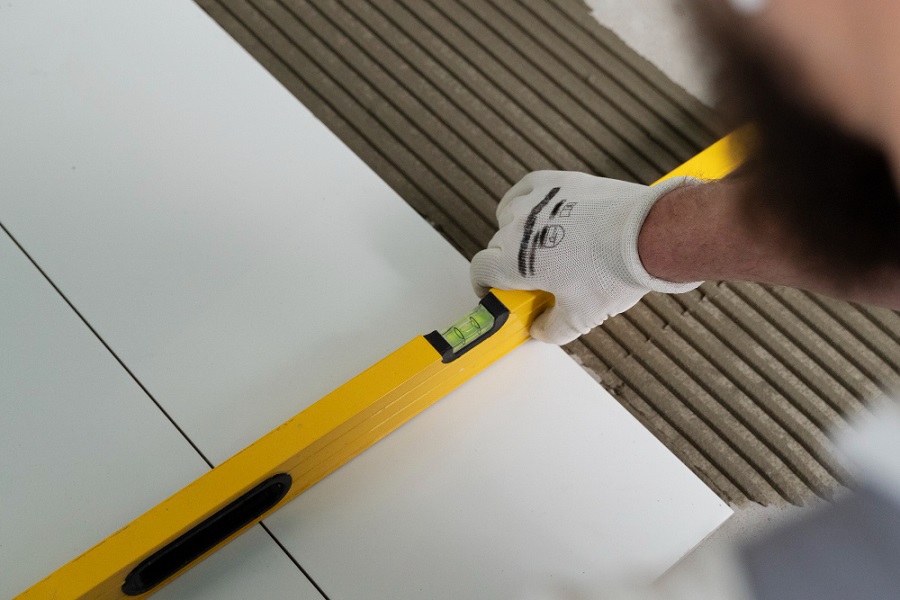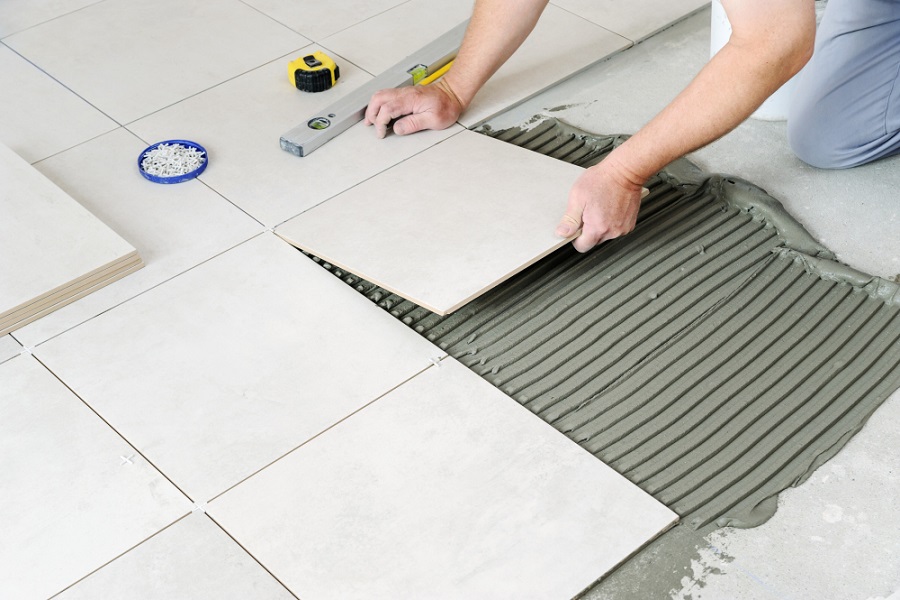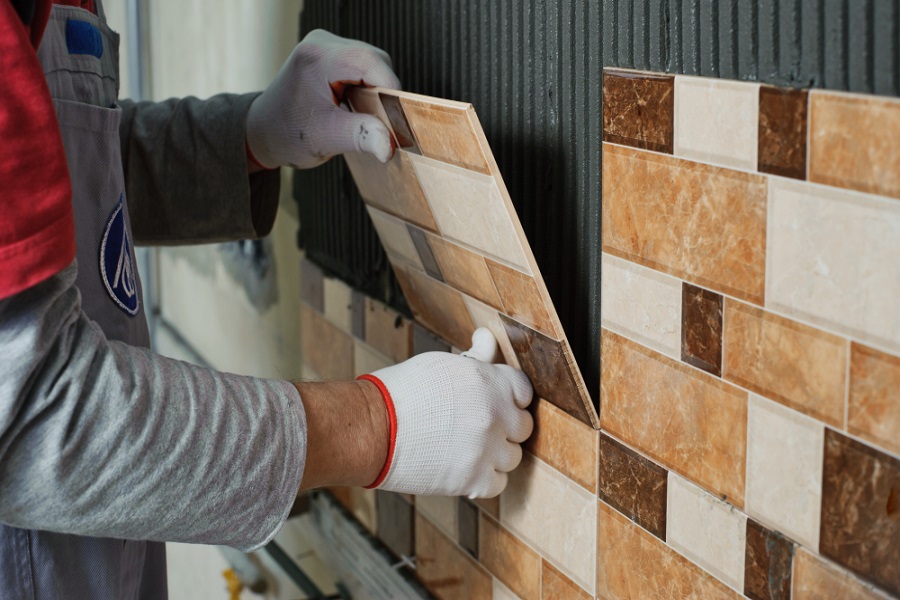Tile flooring can be fundamental in the performance of underfloor heating in your home or building.
In fact, it can be a heated debate within the underfloor heating industry. In this article, we will explore the difference between porcelain and ceramic as the best form of tiling for underfloor heating and guide you toward which tiling will be right for you and your home.
- Differences Between Porcelain and Ceramic Tiling
- Water and Electric Under Tile Heating
- Water Absorption of Ceramic and Porcelain Tiles in a Bathroom
- Disadvantages of Using Porcelain Tiles
- Best Floor Heating System for Ceramic and Porcelain Floor Tiling
- Advantages of Using Porcelain as a Flooring Finish
- Advantages of Using Ceramics as a Flooring Finish
- Disadvantages of Using Ceramics as a Flooring Finish
- Environmental Factors when Choosing Porcelain or Ceramic
Differences Between Porcelain and Ceramic Tiling
Porcelain and ceramic tiling are more similar than you might think since their properties consist of baked clay, and heat molds them together more for a smoother floor finish. However, both forms of tiling have some significant differences:
Types of clay
Ceramic tiles arise from darker clays, while porcelain emerges from whiter ones. Porcelain’s refined clay blends with minerals like quartz and feldspar for added strength. Baked at higher temperatures, porcelain triumphs in durability over ceramics.
Tile Finish
Porcelain and ceramic tiles diverge in their design application. While both can showcase various colours and patterns, porcelain tiling design permeates the entire tile, while ceramic tiling is merely surface-decorated.
Certifications
Porcelain tiles need to be certified by certain groups within the industry to be qualified as official ‘porcelain’ material. The PTCA (Porcelain Tile Certification Agency)[i] will evaluate the porcelain tiles based on their water absorption levels.
| Ceramic | Porcelain | |
| Moisture | More moisture absorbent | Less moisture absorbent |
| Hardness | Softer | Harder |
| Cost | Cheaper | Expensive |
| Usage | Only for use indoors | Can be used indoors and outdoors |
| Cutting | Easier to cut | Harder to cut |
Water and Electric Under Tile Heating
Whether it’s electric or water underfloor heating, both ceramic and porcelain tiles excel as floor finishes. With their heat-conducting prowess, they swiftly distribute warmth, while offering durability and low maintenance. Our underfloor heating systems complement any tiled space, making it a perfect match for all your heating needs.
For Existing Floors
Electric underfloor heating sticky mat kits are a recommended option for those with existing tiled floor finishes. These are relatively quick to install and are easy to use. Remember to install electric underfloor heating insulation boards alongside these to ensure the rooms can stay heated for longer without the worry of it escaping through the floor.
For New Build Homes
If building a home from scratch and using tiled flooring, this gives you the perfect opportunity to install a water underfloor heating system which works great alongside tiled flooring and will provide efficient results.
Thermal Conductivity of Ceramic and Porcelain
Thanks to their excellent thermal conductivity, both ceramic and porcelain tiles quickly warm up and retain heat for extended periods when paired with an underfloor heating system.
Heat-Up Time
For spaces prone to heat loss in homes, like conservatories, heated tiled flooring shines. With low thermal resistance and high thermal mass, ceramic and porcelain tiles excel. Remember, tile thickness affects heat-up time, with thicker tiles requiring more time to warm. Enjoy optimal comfort with porcelain and ceramic tiles, reaching up to 29°C (84°F), perfect for any room in your home.
Water Absorption of Ceramic and Porcelain Tiles in a Bathroom
Bathrooms, often adorned with ceramic or porcelain tiles from floor to ceiling, stand out as prime candidates for underfloor heating. With limited wall space, this heating solution thrives. While both tile types possess some porosity due to their natural composition, porcelain surpasses ceramic in water resistance. Be sure to find out what to consider when designing your dream bathroom.
Water-Resistant Test for Tiles
Meeting PTCA guidelines and the PTCA participation agreement[ii], porcelain earns approval by successfully passing ASTM C373’s Standard Test Method for Water Absorption[iii]. This entails weighing a tile, submerging it in water for 24 hours, and reweighing it. If the weight increase is less than 0.5%, it earns the coveted title of ‘Porcelain’.

Best Choice for a Wet Room: Porcelain Tiling
When it comes to underfloor heating in wet rooms or bathrooms, porcelain tiles are the best due to their superior water resistance. Don’t forget to apply impervious silicone sealant and waterproofing agents when installing a floor heater. Porcelain’s resistance to water absorption also makes it ideal for outdoor use, as rainwater won’t penetrate the tiles excessively. You can learn more about bathroom underfloor heating with our answered FAQs.
Cost of Porcelain Tiling
The cost of porcelain tiling can vary depending on the need for it. In general, ceramic can be cheaper, but this depends on how much of it is needed for the flooring. You can learn about this and more from our article on how much underfloor heating costs.
Disadvantages of Using Porcelain Tiles
- Higher Cost: Porcelain tiles tend to be more expensive compared to ceramic tiles.
- Longer Heat-Up Time: Due to their density and lower thermal conductivity compared to other materials, porcelain tiles may take longer to heat up and distribute warmth evenly across the floor.
- Limited Design Options: Porcelain tiles typically have a more limited colour palette and design options compared to ceramic tiles, which may limit the aesthetic choices available for your underfloor heating project.
- Susceptibility to Cracking: While porcelain tiles are generally durable, they can still be prone to cracking under certain conditions, especially if the subfloor experiences significant movement or if the tiles are improperly installed.
- Challenging Installation: Porcelain tiles are denser and harder than ceramic tiles, making them more challenging to cut, shape, and install, which can lead to increased labour and installation costs.
- Reduced Comfort: Some homeowners may find that porcelain tiles, being denser and less forgiving than other materials, may not provide the same level of comfort and cushioning underfoot, potentially impacting overall comfort levels in heated areas.
- Reflective Surface: Porcelain tiles often have a highly reflective surface, which can create glare or reflections in well-lit rooms, potentially causing visual discomfort for some individuals.
Advantages of Using Porcelain as a Flooring Finish
Thin and mighty, porcelain floor tiles (8mm to 12mm) excel as underfloor heating conduits. Their density serves as natural insulation, retaining heat admirably. The remarkable advantage lies in their resistance to temperature-induced cracks, making porcelain the go-to choice for underfloor heating.
Installation – flooring foundations experience some movement, necessitating an uncoupling membrane for areas exceeding 25m². Porcelain floors demand flexible adhesives and grout, with heating turned off during tiling. Allow around two weeks for full curing of adhesives and grouting before activating underfloor heating.
Advantages of Using Ceramics as a Flooring Finish
Crafted from clay, sand, and water, ceramic tiles undergo kiln baking to eliminate moisture. With excellent thermal conductivity, they prove ideal for underfloor heating. Ceramic tiles boast an earthy colour palette, often showcasing terra-cotta reds. Their softer consistency simplifies installation, facilitating easy cutting and shaping.
Installation – exercise caution as ceramics are prone to cracking and chipping, and they are less durable than porcelain. To prevent cracks, an uncoupling membrane is crucial for underfloor heating applications. Non-flexible adhesives can be used during installation. Like porcelain, ceramic tiles should be laid with the heating off, and activation should be delayed for at least two weeks.

Disadvantages of Using Ceramics as a Flooring Finish
- Lower Heat Conductivity: Compared to some other flooring materials, ceramic tiles have lower heat conductivity, which means they may take longer to heat up and distribute warmth throughout the room when used with underfloor heating systems.
- Limited Insulation: Ceramic tiles are not as effective at insulating heat as materials like stone or porcelain. This means there may be some heat loss through the floor, reducing the overall energy efficiency of the underfloor heating system.
- Greater Susceptibility to Cracking: Ceramics are more prone to cracking and chipping than other flooring materials, especially if the subfloor experiences significant movement or if the tiles are subject to impact or stress. This can be a concern when installing underfloor heating, as the heat and subfloor movements can potentially exacerbate the risk of cracks.
- Difficulty in Cutting and Shaping: Ceramic tiles are typically harder and more brittle compared to other flooring materials, making them more challenging to cut and shape during installation. This can result in higher labour and installation costs.
- Limited Design Options: While ceramic tiles offer a wide range of design possibilities, their colour palette and design options may be more limited compared to materials like porcelain. This can restrict the aesthetic choices available for underfloor heating projects.
- Uneven Surface: Ceramic tiles may have slight irregularities on the surface, which can create an uneven feel underfoot. This may impact comfort levels, particularly in areas with prolonged standing or walking.
- Potential Staining: Ceramic tiles are generally more porous compared to porcelain, making them more susceptible to staining, especially in areas like kitchens or bathrooms where spills and stains are more likely to occur. Proper sealing and maintenance are required to mitigate this risk.
Environmental Factors when Choosing Porcelain or Ceramic

Underfloor heating works well with both ceramic and porcelain tiles, leaving environmental considerations to guide your selection. Porous ceramics may not suit stain-prone kitchens. Opt for porcelain’s cool elegance with whites and greys. Yet, for a homely or Mediterranean ambiance, ceramics are the better option.
Choose the Right Tiling for Your Underfloor Heating
Both porcelain and ceramic tiling work very efficiently and both can be the best tiling for underfloor heating. While porcelain boasts superior water resistance and durability, ceramic tiles offer a diverse colour palette and a softer installation process. Understanding the unique properties of each tile type allows you to make an informed choice for a cosy home. For instance, you can commonly find porcelain or ceramic tiles in kitchens – however, does underfloor heating in kitchens work? Learn more now.
FAQs
Is porcelain or ceramic tile better for underfloor heating?
Both porcelain and ceramic tiles can be used with underfloor heating systems. However, porcelain tiles are generally considered to be better suited for underfloor heating. Porcelain tiles have a lower thermal conductivity, which means they retain heat better and allow for more efficient heat transfer to the surface. This makes them an ideal choice for underfloor heating systems.
What is the difference between porcelain or ceramic tiles?
Porcelain and ceramic tiles are both made from clay and other natural materials. The main difference lies in their composition and manufacturing process. Porcelain tiles are made from a denser clay and fired at higher temperatures, resulting in a more durable and less porous tile. Ceramic tiles are made from a mixture of clay and other materials and are fired at lower temperatures. Porcelain tiles are generally more resistant to moisture, stains, and wear compared to ceramic tiles.
Are porcelain tiles more expensive than ceramic tiles?
Porcelain tiles are generally more expensive than ceramic tiles due to their higher manufacturing costs and increased durability. However, the price can vary depending on the specific brand, design, and quality of the tiles. It’s best to compare prices and consider the long-term benefits of using porcelain tiles, such as their durability and energy efficiency with underfloor heating.
Can both porcelain and ceramic tiles handle the heat from underfloor heating systems?
Both porcelain and ceramic tiles can handle the heat from underfloor heating systems. However, porcelain tiles are known to be more efficient at conducting and retaining heat due to their lower thermal conductivity. This means that they can provide more even and comfortable heating across the floor surface.
Which type of tile heats up faster with underfloor heating?
Porcelain tiles tend to heat up faster with underfloor heating due to their lower thermal conductivity. They allow heat to transfer more efficiently, resulting in quicker warm-up times and more efficient energy usage. Ceramic tiles, while still suitable for underfloor heating, may take slightly longer to heat up.
Can I use any type of porcelain or ceramic tile with underfloor heating?
In general, most types of porcelain or ceramic tiles can be used with underfloor heating. However, it is important to check the manufacturer’s specifications and recommendations to ensure that the specific tile you choose is suitable for use with underfloor heating. Look for tiles that are specifically labelled as compatible with underfloor heating systems.
Are there any specific installation considerations for porcelain or ceramic tiles with underfloor heating?
When installing porcelain or ceramic tiles with underfloor heating, it is essential to follow the manufacturer’s instructions and guidelines for both the tiles and the underfloor heating system. Proper insulation and the use of flexible adhesives are important to prevent cracking or damage to the tiles. It’s also recommended to consult with a professional installer experienced in underfloor heating systems for the best results.
Sources
[i] PTCA Online. (n.d.). Retrieved from: http://www.ptcaonline.org/ [accessed 21/06/23]
[ii] PTCA. (n.d.). PTCA Participation Agreement. [online] Retrieved from: https://tcnatile.com/wp-content/uploads/2023/01/ptca-participation-agreement.pdf [accessed 21/06/23]
[iii] ASTM International. (2018). ASTM C373-18: Standard Test Method for Water Absorption, Bulk Density, Apparent Porosity, and Apparent Specific Gravity of Fired Whiteware Products. [online] Retrieved from: https://www.astm.org/c0373-18.html [accessed 21/06/23]
